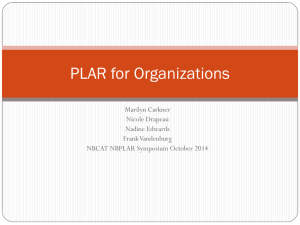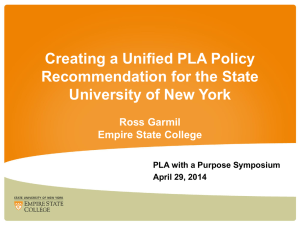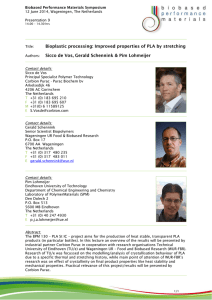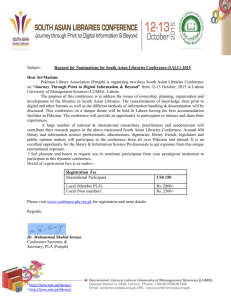ISOLATION AND SCREENING OF POLYLACTIC ACID
advertisement
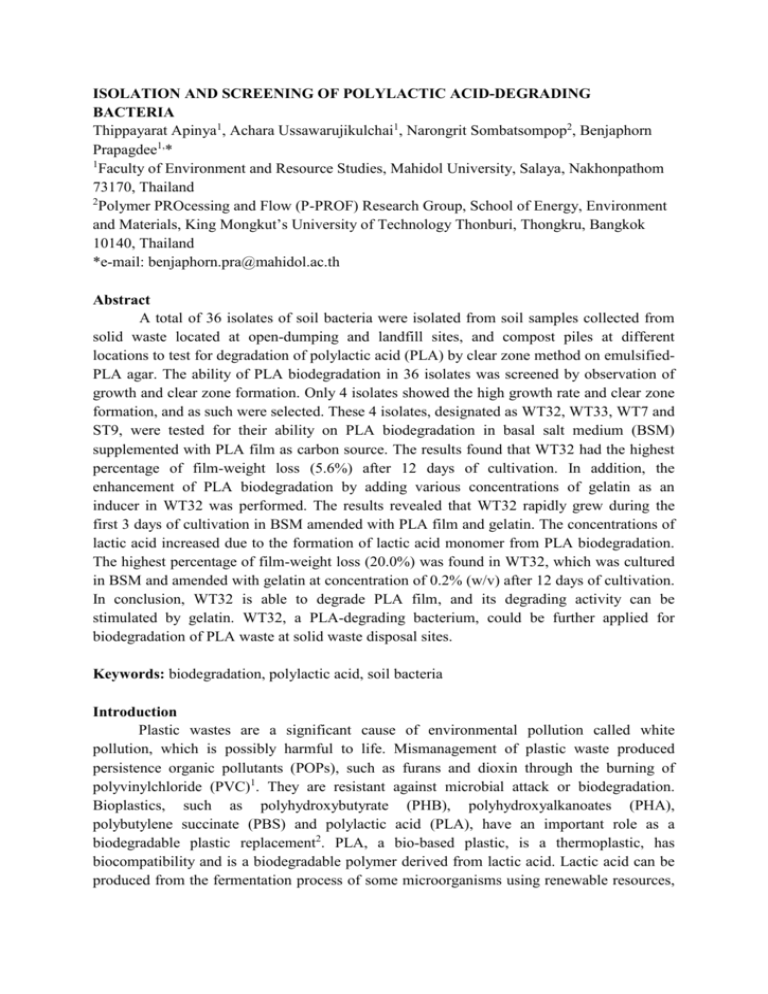
ISOLATION AND SCREENING OF POLYLACTIC ACID-DEGRADING BACTERIA Thippayarat Apinya1, Achara Ussawarujikulchai1, Narongrit Sombatsompop2, Benjaphorn Prapagdee1,* 1 Faculty of Environment and Resource Studies, Mahidol University, Salaya, Nakhonpathom 73170, Thailand 2 Polymer PROcessing and Flow (P-PROF) Research Group, School of Energy, Environment and Materials, King Mongkut’s University of Technology Thonburi, Thongkru, Bangkok 10140, Thailand *e-mail: benjaphorn.pra@mahidol.ac.th Abstract A total of 36 isolates of soil bacteria were isolated from soil samples collected from solid waste located at open-dumping and landfill sites, and compost piles at different locations to test for degradation of polylactic acid (PLA) by clear zone method on emulsifiedPLA agar. The ability of PLA biodegradation in 36 isolates was screened by observation of growth and clear zone formation. Only 4 isolates showed the high growth rate and clear zone formation, and as such were selected. These 4 isolates, designated as WT32, WT33, WT7 and ST9, were tested for their ability on PLA biodegradation in basal salt medium (BSM) supplemented with PLA film as carbon source. The results found that WT32 had the highest percentage of film-weight loss (5.6%) after 12 days of cultivation. In addition, the enhancement of PLA biodegradation by adding various concentrations of gelatin as an inducer in WT32 was performed. The results revealed that WT32 rapidly grew during the first 3 days of cultivation in BSM amended with PLA film and gelatin. The concentrations of lactic acid increased due to the formation of lactic acid monomer from PLA biodegradation. The highest percentage of film-weight loss (20.0%) was found in WT32, which was cultured in BSM and amended with gelatin at concentration of 0.2% (w/v) after 12 days of cultivation. In conclusion, WT32 is able to degrade PLA film, and its degrading activity can be stimulated by gelatin. WT32, a PLA-degrading bacterium, could be further applied for biodegradation of PLA waste at solid waste disposal sites. Keywords: biodegradation, polylactic acid, soil bacteria Introduction Plastic wastes are a significant cause of environmental pollution called white pollution, which is possibly harmful to life. Mismanagement of plastic waste produced persistence organic pollutants (POPs), such as furans and dioxin through the burning of polyvinylchloride (PVC)1. They are resistant against microbial attack or biodegradation. Bioplastics, such as polyhydroxybutyrate (PHB), polyhydroxyalkanoates (PHA), polybutylene succinate (PBS) and polylactic acid (PLA), have an important role as a biodegradable plastic replacement2. PLA, a bio-based plastic, is a thermoplastic, has biocompatibility and is a biodegradable polymer derived from lactic acid. Lactic acid can be produced from the fermentation process of some microorganisms using renewable resources, such as whey, sugar cane, potato and cassava3. PLA products are used in cosmetic surgery products, drug-delivery systems, and specialty textiles and packaging. Although PLA is an important bioplastic for replacing petroleum-based plastics, an enormous quantity of PLA waste without suitable management will cause an emerging problem for solid waste management. Thus, biodegradability of PLA by microorganisms in the environment must be studied to address and manage the new environmental problem. The degradability of PLA has been investigated with respect to chemical hydrolysis and enzymatic degradation, nevertheless it has been reported to possess PLA-degrading activity of microorganisms4. Soil is an important medium for supporting microbial growth and microbial diversity. General populations of microorganism in natural soil are mostly bacteria. Bacteria have an important role in creating new PLA-degrading enzymes. Bacillus smithi, Bacillus brevis, and Paenibacillus amylolyticus were found to degrade PLA5. Therefore, this research aims to isolate the PLA-degrading bacteria from soil samples collected from solid waste located at open-dumping and landfill sites, and compost piles. Selected PLA-degrading bacteria were tested for their ability regarding PLA biodegradation in PLA film containing BSM. In addition, the induction of PLA biodegradable activity by selected PLA-biodegrading bacteria using various concentrations of gelatin as an inducer was also investigated. Methodology Isolation of PLA-degrading bacteria Soil samples were collected from solid waste open dumping and landfill sites and compost piles different locations. All samples were kept in the sterile container. One-gram of soil sample was suspended in 9 mL of sterile normal saline. A 100 µL of each sample was spread on the emulsified PLA agar plate containing 0.1% PLA (w/v) (PLA 2002D, NatureWorks, USA).The emulsified PLA agar containing 0.1% PLA (w/v) was prepared according to the methods of Pranamuda and Tokiwa6 (1999). All plates were incubated at 30oC for 3-5 days until appeared colony was observed. Growth and clear zone around bacterial colony on the emulsified PLA agar is considered to be the PLA-degrading bacteria. The colonies surrounded with clear zone with difference colony morphology were picked up and patched on the new emulsified PLA agar plates to ensure the forming of clear zone. Screening of PLA-degrading bacteria in submerged culture Degradation of PLA was carried out in basal salt medium (BSM)6 in 125-mL Erlenmeyer flasks with triplicates. PLA film was prepared using by dissolving PLA granule in dichloromethane. A film was carried out by molding to get a PLA net weight of 50 mg (2×3cm). The resultant of film is transparent. It was dried by hotplate about 10 min. PLA film was sterilized with 5% sodium hypochlorite for 10 sec and washed twice with sterile distilled water. Four pieces of sterilized PLA film were put in the culture flask. The inoculum of selected bacteria was inoculated in BSM to give an initial cell density (OD600) of approximately 0.2. All flasks were incubated at 30oC with shaking at 150 rpm for 12 days. PLA film was aseptically collected every 3 days and measured the film dry weight. Isolate which provided the highest percentage of film-weight loss was selected for further experiment. Effects of gelatin on PLA biodegradation by selected PLA-degrading bacterium Selected PLA-degrading bacterium was cultured in BSM amended with PLA film and various concentration of gelatin as an inducer7, including 0%, 0.05%, 0.1%, 0.2% and 0.5% (w/v). All flasks were incubated at 30oC with shaking at 150 rpm for 12 days. PLA film and cell suspension were aseptically collected every 3 days and determined film dry weight, cell density (OD600), lactic acid and pH. Results Number of viable bacteria in soil samples that able to grow on the emulsified PLA agar The number of viable bacteria in 10 soil samples collected from solid waste open dumping and landfill sites and compost piles were enumerated in the emulsified PLA agar. The highest number of viable bacteria (5.2 × 106 CFU/g) that can grow on the emulsified PLA agar using PLA as a carbon source was found in the soil collected from open dumping site at Koh Chang, Trad province. The number of bacteria and number of selected isolates show in Table 1. A total of 36 isolates that exhibited different colony morphology and clear zone on the emulsified PLA agar plate were selected. Table 1.Sources, number of bacteria and selected isolates from soil samples Source Compost pile I at FERS, Nakhonpathom Compost pile II at FERS, Nakhonpathom Compost pile I at MU, Nakhonpathom Compost pile II at MU, Nakhonpathom Number of viable bacteria (CFU/g) 6 4.2 × 10 3 4.4 × 10 4 3.2 × 10 6 4.0 × 10 6 Compost pile at Salaya, Nakhonpathom 2.4 × 10 Waste disposal site I at Onnuch, Bangkok 8.9 × 10 Waste disposal site II at Onnuch, Bangkok Open dumping site at Koh Chang, Trad Landfill site I at Nonthaburi Landfill site II at Nonthaburi Total 5 4 3.2 × 10 6 5.2 × 10 6 3.7 × 10 4 8.7 × 10 Number of selected isolate (Isolates) 3 3 5 6 2 5 6 3 2 1 36 All 36 bacterial isolates were re-streaked on the emulsified PLA agar to ensure the growth, clear zone formation and pure culture. The result found that only 4 isolates showed the rapidly growth and clear zone on the emulsified PLA agar and designated as WT32, WT33, WT7 and ST9. Isolate WT32 and WT33 were isolated from soil collected from waste disposal site at Bangkok and WT7 was isolated from compost pile collected at FERS, Nakhonpathom. Isolate ST9 was isolated from soil collected at landfill site, Nonthaburi. The colony and cells morphology of WT32, WT33, WT7 and ST9 were characterized as shown Figure 2. The results found that isolate WT32 and ST9 are Gram negative bacteria and WT33 and WT7 are Gram positive bacteria. (A) (B) (C) (D) Figure 1. Bacterial colony of selected isolates including, (A) WT32 (B) WT33 (C) WT7 (D) ST9 cultured on LB agar plates and cell morphology observed under light microscope at 1,000X magnification Ability of selected bacteria on PLA film biodegradation in submerged culture All selected isolates of bacteria, namely WT32, WT33, WT7 and ST9 were studied their PLA film biodegradable activity in submerged culture. PLA film biodegradation of 4 isolates presented in the percentages of film weight loss shows in Figure 2. After 12 days of cultivation, WT32 showed the percentages of film weight loss (5.6%) higher than that of other isolates. The percentages of film-weight loss of WT33, WT7 and ST9 were 4.1%, 2.8% and 2.1%, respectively, while the film weight of uninoculated control had no significantly changed. Therefore, WT32 as a potent PLA-degrading bacterium was selected for further experiment. Figure 2.The time course of PLA film biodegradation by 4 isolates of selected bacteria in BSM supplemented with PLA film at 30oC for 12 days compared to the uninoculated control Stimulation of PLA film biodegradation by selected PLA-degrading bacterium using gelatin as an inducer The effects of various concentrations of gelatin, including 0, 0.05, 0.1, 0.2 and 0.5% (w/v) on the induction of PLA biodegradation by WT32 were investigated. The results showed that the growth of WT32 increased with time and entered the stationary phase of growth at 3 days of incubation periods (Figure 2(A)). The highest growth was found in the culture medium amended with 0.5% (w/v) of gelatin because this bacterium can use gelatin as the carbon source for its growth. The bacterial growth increased swiftly for initial stage of growth by increasing of the concentration of gelatin. In Figure 2(B), pH value in culture increased at the initial stage of growth and slightly decreased corresponding to the occurrence of lactic acid concentration. In addition to PLA film biodegradation, WT32 assimilated lactic acid, the major biodegradable product of PLA. The concentration of lactic acid increased according to L-lactic acid monomer from the biodegradation of PLA film. Gelatin at concentrations of 0.1 and 0.2% (w/v) can induce the increasing of lactic acid concentrations by 326 and 371 µg/mL, respectively (Figure 2(C)). The effect of gelatin on the induction of PLA film biodegradation by WT32 was observed using the percentage of film-weight loss (Figure 2(D)). PLA film biodegradation by WT32 was significantly increased by addition of gelatin in BSM broth. After 12 days of cultivation, PLA film had been disintegrated significantly at 0.2% (w/v) of gelatin by decreasing film-weight loss to 20.0%. Gelatin at concentrations of 0.5%, 0.1%, 0.05% and 0% showed the percentages of film-weight loss by 7.4, 9.0, 2.7 and 1.7%, respectively. (B) Cell density (OD600) (A) (C) (D) Figure 3. Biodegradation of PLA film by stain WT32 in broth culture amended with difference concentration of gelatin (A) Growth of stain WT32 (B) pH of culture broth (C) Lactic acid concentration in culture broth (D) %Weight loss of film during degradation of PLA Figure 4 shows the photograph of the disintegration of PLA film by WT32 compared to the uninoculated control. It was studied in BSM culture broth containing 0.2% (w/v) of gelatin at 30oC with shaking at 150 rpm for 12 days. The degraded PLA film was determined by visual observation. At the beginning, the originally of PLA film was completely transparent and after that PLA film became a little opaque in the beginning then, rough and crack during the test period. (A) 0d 3d 6d 9d 12 d (B) 0d 3d 6d 9d 12 d Figure 4. Disintegration of PLA film by (A) WT32 in BSA amended with 02% (w/v) of gelatin and (B) the uninoculated control Discussion and Conclusion The problem of non-degradable plastics is resistant against microbial attack because the indigenous microorganisms in the environment cannot produce specific polymer degrading-enzymes that are able to degrade synthetic polymers8. Hence, the development of PLA, an biodegradable plastics, has become necessary to replace petroleum-based plastics. However, the stability of PLA and low number of PLA degraders distributed in the natural environment caused slowly biodegradation of PLA wastes9. To prevent a new environmental problem caused by PLA wastes, PLA degraders are desirable for their application to PLA waste management. The growth and clear zone formation on the agar containing tested polymer is a simple method of studying microbial degradation of polymers6. The study of Tokiwa and Jarerat10 (2004) reported that the number of the polyester-degrading microbes decreased in the order of PHB = PCL > PBS > PLA. Few of microorganisms were reported as PLA-degraders such as Bacillus smithi11, Bacillus brevis12, Paenibacillus amylolyticus13, Amycolatopsis sp.6, Kibdelosporangium aridum14, and Saccharothrix waywayandensis4. Enzymes that involved in PLA biodegradation are protease and lipase9. PLAdegrading enzymes produce varied between different microbial strains and different inducers. PLA-degrading enzymes from PLA-degrading microorganisms can be induced by several proteinous materials e.g. gelatin, silk fibroin, elastin7, 9. Gelatin can be used as an inducer for PLA biodegradation process in several microorganisms e.g. P. amylolyticus13, Lentzea waywayandensis14. Our results found that gelatin at concentration of 0.2% (w/v) can strongly induce PLA biodegradation by WT32. The study of Jarerat and Tokiwa4 (2003) reported that more than 95% of PLA film can be degraded by S. waywayandensis cultured in liquid culture containing 0.1% (w/v) gelatin. These findings could be concluded that WT32 can degrade PLA film by 20.0% when cultivated in BSM amended with 0.2% (w/v) of gelatin. The stimulating of the biodegradation of PLA wastes by bioaugmentation with a potent PLAdegrading bacterium could be useful for PLA waste treatment and disposal. References 1. 2. 3. 4. 5. 6. 7. 8. 9. 10. 11. 12. 13. 14. Shah AA, Hasan F, Hameed A, Ahmed S. Biological degradation of plastics: a comprehensive review. Biotechnology Advances 2008;26:246-65. Nampoothiri KM, Nair NR, John RP. An overview of the recent developments in polylactide (PLA) research. Bioresource Technology 2010;101:8483-501. John RP, Nampoothiri KM, Pandey A. Fermentative production of lactic acid from biomass: an overview on process developments and future perspectives. Applied Microbiology and Biotechnology 2007;74:52434. Jarerat A, Tokiwa Y. Degradation of poly (L-lactide) by Saccharothrix waywayandensis. Biotechnology Letters 2003;25:401-4. Konkit M, Jarerat A, Khanongnuch C, Lumyong S, Pathom-aree W. Poly(lactide) degradation by Pseudonocardiaalni AS4.1531T. Chiang Mai Journal of Science 2012;39:128-32. Pranamuda H, Tokiwa Y. Degradation of poly(L-lactide) by strains belonging to genus Amycolatopsis. Biotechnology Letters 1999;21:901-5. Jarerat A, Tokiwa Y, Tanaka H. Microbial poly(L-lactide)-degrading enzyme induced by amino acids, peptides, and poly(L-amino Acids). Journal of Polymers and the Environment 2004;12:139 -46. Mueller RJ. Biological degradation of synthetic polyesters-enzymes as potential catalysts for polyester recycling. Process Biochemisty 2006;41:2124-8. Tokiwa Y, Calabia BP. Biodegradability and biodegradation of poly(lactide). Applied Microbiology and Biotechnology 2006;72:244-51. Tokiwa Y, Jarerat A. Biodegradation of poly(L-lactide). Biotechnology Letters 2004;26:771-7. Sakai K, Kawano H, Nakamura M, Moriguchi M. Isolation of a thermophilic poly-L-lacide degrading bacterium from compost and its enzymatic characterization. Journal of Bioscience and Bioengineering 2001;92:298-300. Tomita K, Kuroki Y, Nakai K. Isolation of thermophiles degrading poly(L-lactic acid). Journal of Bioscience and Bioengineering1999;87:752-5. Teeraphatpornchai T, Nakajima A. T, Shigeno A.Y, Nakayama M, Nomura N, Nakahara T, Uchiyama H. Isolation and characterization of a bacterium that degrades various polyester-based biodegradable plastics. Biotechnology Letters 2003;25:23-8. Jarerat A, Tokiwa Y, Tanaka H. Poly(L-lactide) degradation by Kibdelosporangium aridum. Biotechnology Letters 2003;25:2035-8. Acknowledgements: This work was supported by The Thailand Research Fund (TRF) under the TRF Senior Research Scholar (grant no. RTA5580009).

